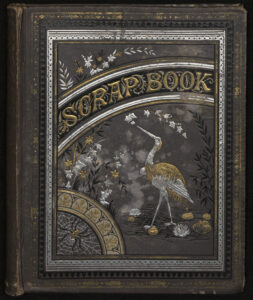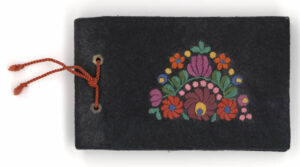Cut & Paste: scrapbooking then and now

Tomorrow, May 4th, is National Scrapbook Day. Each year on the first Saturday in May, National Scrapbook Day invites the country to bring their talents together to celebrate the art of scrapbooking.
As early as the Middle Ages, it was quite common for well-educated people to keep personal diaries or journals. During the Renaissance period, it became popular for noble and educated Europeans to keep what were called “commonplace books.” These books had a close resemblance to what today we would call “bullet journals” – a bound journal of blank pages that contains notes from various sources on assorted topics. Commonplace books were not personal diaries or even a way of recording the owner’s inner thoughts, but rather a way of collecting and organizing a variety of information and material that came to the person from a variety of sources – a gathering of informational “scraps.”

Following the invention of the printing press, family bibles became one of the earliest forms of family record keeping. Many families used blank end pages at the end and the beginning of the text to record the full names, births, deaths, and marriage dates of children and other family members. Families sometimes kept important documents between pages for safekeeping. During the 1800s, the emergence and increased accessibility of printed material sparked a new trend. People began filling blank, bound books – previously used for journals or artwork – with clippings, cards, printed memorabilia, and other “scraps” such as journal entries, hand-drawn sketches, and watercolors.
Scrapbooks were not just limited to personal and family memories. In 1839, a group of early slavery abolitionists from the American Anti-Slavery Society published a book called “American Slavery as It Is: Testimony of a Thousand Witnesses.” The book was an account of the actual treatment of slaves by their owners, based on a scrapbook of newspaper accounts assembled by the group, and is still considered to have been a powerful tool in the abolition movement. Frederick Douglass instructed the readers of his abolitionist newspaper in 1854 to keep copies of a story about “Black heroes” (“Colored men! Save this extract. Cut it out and put it in your Scrap-book”). William Henry Dorsey produced nearly 400 books of clippings about Black life, many about African slaves alongside news stories of Black soldiers fighting for the North in the Civil War.
In 1872, Mark Twain got in on the trend by inventing and patenting an innovative “self-pasting” scrapbook that had gummed strips preinstalled. It became a profitable side business for Twain, with an 1885 news story claiming scrapbook sales accounted for 20 percent of his publishing income.

In the early 20th century, scrapbooking changed. People increasingly saved trinkets and scraps recording their own personal experiences, such as tickets of shows they had seen, wrappers from candy bars, and snapshots taken with the new and inexpensive Brownie camera. Publishers created “memory books” to encourage Boy Scouts, college students and new mothers to save tokens of personal experience.
Paper scrapbooking surged in the 1990s, propelled by a growing interest in genealogy, and companies cleverly produced lines of easy-to-use supplies. Today, many hobbyists say the pastime is transforming, becoming digital, and the rise of online tools like Pinterest are shrinking the urge to save physical scraps. However, when a significant event happens, people still turn to old-fashioned media and souvenirs, like newspapers.
There are many scrapbooks throughout the Ohio History Connection’s collections, and many from other institutions from across the state can be found on the Ohio Memory website. Browse the collections to take a journey through history and you might find inspiration to start a scrapbook of your own.
Thank you to Ashely Rodriguez, Digital Projects Coordinator at the Ohio History Connection, for this week’s post!



Leave a Reply
You must be logged in to post a comment.